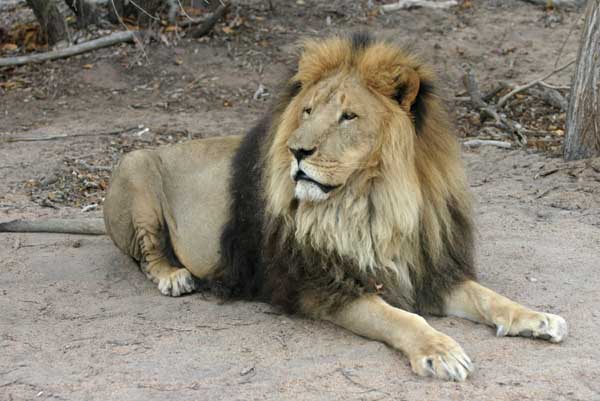



Posted on 04/09/2008 1:12:41 PM PDT by blam
"Tower Lions" May Help Resurrect Extinct African Breed?
James Owen
for National Geographic News
April 4, 2008
An extinct breed of lion from North Africa was held at the Tower of London in medieval times, a new study shows.
A pair of skulls unearthed from the tower's moat in the 1930s belonged to Barbary lions, a subspecies that has since died out in the wild.
The discovery raises the possibility that descendants of Barbary lions may still survive in captivity, which could help efforts to resurrect the dark-maned breed, researchers say.
The lions' North African roots were revealed by analysis of mitochondrial DNA, a genetic marker passed between females.
What's more, the DNA reveals that the two animals represent the oldest confirmed Barbary lion remains in the world, the study team said.
The findings are reported in the current issue of the journal Contributions to Zoology.
Exploited Population
Radiocarbon dating of the lion skulls in 2005 indicated that the two male cats first came to the tower in the 13th century, the oldest being dated to between A.D. 1280 and 1385.
At that time the palace housed the Royal Menagerie, a diverse collection of exotic animals owned by the reigning monarch.
Carcasses of dead animals from the menagerie were likely thrown into the moat, where they became buried in silt, said study team member Richard Sabin of the Natural History Museum in London.
The environment preserved the lion skulls remarkably well, allowing genetic samples to be taken, Sabin said.
The DNA analysis supports historical evidence suggesting that Barbary lions had an ancient presence in Europe, he added.
"We know that the Romans were exploiting the short distance across the Mediterranean to North Africa to take animals for gladiatorial games and exhibitions," he said. (See a map of the region.)
"The Barbary lion population had been exploited for at least a couple of thousand years. It was quite easy for people to nip over from Italy, Spain, and Portugal to pick them up."
The last reported Barbary lion in the wild was shot in the Atlas Mountains in northwest Africa in 1922, Sabin said.
Since then, hopes of reviving the subspecies have focused on captive lions, especially those showing signs of the Barbary's most distinctive feature: a noticeably long, dark mane.
"Because we have these good genetic samples from known purebred Barbary lions, we can compare DNA from those ancient specimens to the ones that potentially are still alive in zoos today," Sabin said.
"There may be descendents of them still in the U.K. in zoos and wild-animal parks, but this is something that would need to be ascertained through genetic study."
Opening Doors
Nobuyuki Yamaguchi of the University of Oxford's Wildlife Conservation Research Unit is leading efforts to trace potential Barbary survivors.
Yamaguchi, who co-authored the new study, says that to date no living Barbary lions have been confirmed in captivity, despite various rumors to the contrary.
While he says the Tower of London find doesn't directly assist his search, he hopes it might help widen the net.
"For example, once many people know that a DNA test would be available for checking if a lion might be a Barbary, museums and zoos may want to carry out the test," he said.
"In this context, our recent works can provide the key if people would like to open the door."
Lions have been known to breed well in captivity—even when kept in unsuitable conditions, such as those before the 20th century—Yamaguchi noted.
"Therefore, it is natural for people to consider that there must be some zoo lions today that carry the Barbary blood," he said.
The long-term aim, he added, is to return the lion to part of its former range in North Africa.
I'm guessing the people of this lion's former range have not been included in the decision making.
here kitty kitty...
Interesting! But not a project I’d throw money at.
Amazing animal. What an interesting possibility.
Saber-toothed tigers..........San Francisco?????? Hold the phone, they may have something here.
Maybe not saber-toothed but those are some impressive choppers in the top picture.
and in reply to your original post, no need to consult the locals. “Animals are people too” and all that.
Just a macabre fantasy I guess.
decimon said: Maybe not saber-toothed but those are some impressive choppers in the top picture.
I believe USMCGunnut was saying restoring Saber-tooths to their former range in SF might not be such a bad idea if it could be done:). I happen to agree. A few Mammoths and Cave Bears might also be considered.
C'mon, do you really want to see those riding floats in leather speedos?
They want to restore nature, predators and all. And they have stated that killing animals is wrong.
“They want to restore nature, predators and all. And they have stated that killing animals is wrong.”
Guess they missed Jurrasic Park : ) Good thing I have some appropriate calibers to deal with those.
|
|
|||
Gods |
Thanks Blam. |
||
|
· Mirabilis · Texas AM Anthropology News · Yahoo Anthro & Archaeo · · History or Science & Nature Podcasts · Excerpt, or Link only? · cgk's list of ping lists · |
|||
All that work to salvage a subspecies surely isn’t random.
And yet some preach that everything came to be without intelligent design.
Somebody’s lion, indeed.
If these dark-maned lions died out in 1922, where did we get colored pictures of them?
And Sabre toothed tigers are not a good idea for San Francisco — they shoot tigers there...;~)
Disclaimer: Opinions posted on Free Republic are those of the individual posters and do not necessarily represent the opinion of Free Republic or its management. All materials posted herein are protected by copyright law and the exemption for fair use of copyrighted works.